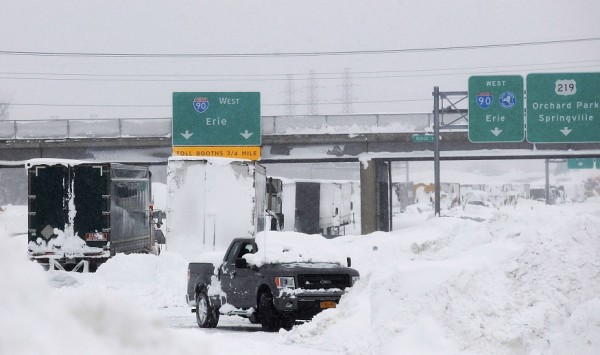Humungous U.S. Snowstorms Triggered by Climate Change
| Ana Verayo | | Nov 20, 2014 12:51 AM EST |
(Photo : Reuters) Vehicles litter the highway in West Seneca, New York after an autumn blizzard dumped a year's worth of snow on western New York state.
The year's first major snowstorm in the U.S. dumped a whopping five feet of snow on some areas in upstate New York on November 19. Weathermen fear this could be the toughest winter yet for most of the U.S.
Climate change is largely to blame for this phenomenon as shifting weather patterns caused these drastic changes in air pressure at the root of Tuesday's staggering amount of snowfall in Buffalo and other areas of upstate New York, said Thomas Peterson from the National Oceanic and Atmospheric Administration's National Climatic Data Center (NOAA).
Like Us on Facebook
Peterson, who is also the president of the World Meteorological Organization's Commission for Climatology, said cold air travelled down from Canada earlier than expected. This phenomenon took place when the Great Lakes were still warm.
The monster snowstorms blanketing the northeast would have been here if this cold air arrived in January when the Great Lakes are colder as opposed to its present warm waters in November.
This is clear evidence average global temperatures have risen. Extreme weather patterns are leading to colder winters in some areas of the world. This year's record snowfall in the U.S. is reminiscent of the polar vortex last year that sucked in cold northern air and dumped this as massive snowfalls.
NOAA said monthly global average temperatures has been higher for the past 355 months. September was the hottest month ever since 1880.
Since global temperatures are now warmer, it is affecting atmospheric patterns in the jet stream that moves across the U.S. The stream has diverged towards Canada (where it's very cold) and has turned south towards the U.S., said John Zobitz from Minnesota's Augsburg College, an expert on climate change.
He adds this temperature change will make patterns of precipitation change in some places. Some places will be wetter than average and some will be drier, too.
Even if the rest of the world is getting warmer, it also means some places also become a lot colder, Zobitz concludes.
TagsUS Snowstorms Apparently Caused by Global Warming, snowstorm US, US, buffalo new york, global warming, snowstorm US global warming
©2015 Chinatopix All rights reserved. Do not reproduce without permission
EDITOR'S PICKS
-

Did the Trump administration just announce plans for a trade war with ‘hostile’ China and Russia?
-

US Senate passes Taiwan travel bill slammed by China
-

As Yan Sihong’s family grieves, here are other Chinese students who went missing abroad. Some have never been found
-

Beijing blasts Western critics who ‘smear China’ with the term sharp power
-

China Envoy Seeks to Defuse Tensions With U.S. as a Trade War Brews
-

Singapore's Deputy PM Provides Bitcoin Vote of Confidence Amid China's Blanket Bans
-

China warns investors over risks in overseas virtual currency trading
-

Chinese government most trustworthy: survey
-

Kashima Antlers On Course For Back-To-Back Titles
MOST POPULAR
LATEST NEWS
Zhou Yongkang: China's Former Security Chief Sentenced to Life in Prison

China's former Chief of the Ministry of Public Security, Zhou Yongkang, has been given a life sentence after he was found guilty of abusing his office, bribery and deliberately ... Full Article
TRENDING STORY

China Pork Prices Expected to Stabilize As The Supplies Recover

Elephone P9000 Smartphone is now on Sale on Amazon India

There's a Big Chance Cliffhangers Won't Still Be Resolved When Grey's Anatomy Season 13 Returns

Supreme Court Ruled on Samsung vs Apple Dispute for Patent Infringement

Microsoft Surface Pro 5 Rumors and Release Date: What is the Latest?










